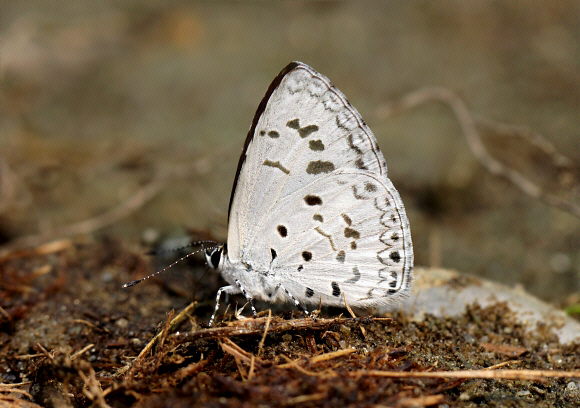
Introduction
The genus Acytolepis comprises 5 species found variously from India and Sri Lanka to Japan, and throughout the south-east Asian islands from Sumatra to the Moluccas.
The upper surface of the wings of all species are very pale silvery blue, with blackish margins that are broader in the female than in the male. The pattern of black spots and grey markings on the silvery grey underside is found in several other genera including Plautella, Udara and Megisba so close attention to the configuration of the markings is essential when identifying these butterflies.
Acytolepis puspa is found from India and Sri Lanka to Malaysia and Hong Kong. It also occurs on all major islands from Sumatra and Borneo to Sulawesi.
Habitats
The common butterfly is found primarily in disturbed lowland forests where it can be seen along unmetalled roads, forest tracks, river beaches, gardens, parks and archaeological sites. It is found at elevations between sea level and about 800m.
Lifecycle
The larvae are polyphagous, feeding on the leaves of numerous trees and bushes among which are Dystilium ( Hamamelidaceae ), Schleichera ( Sapindaceae ), Photinia, Rosa, Prunus, Malus, Spiraea, Aruncus, Chaenomeles ( Rosaceae ), Myrica ( Myricaceae ), Quercus ( Fagaceae ), Sapindus, Litchi, Dimocarpus ( Sapindaceae ), Bridelia ( Euphorbiaceae ), Shorea ( Dipterocarpaceae ), Peltophorum ( Fabaceae ), Glochidion ( Phyllanthaceae ), Astilbe ( Saxifragaceae ), Celtis ( Ulmaceae ), Hiptage ( Malpighiaceae ), Xylia ( Mimosaceae ), Rhododendron ( Ericaceae ) & Viburnum ( Caprifoliaceae ).
Adult behaviour
The butterflies are only active in hot sunny weather. Males are usually seen either singly or in small numbers amidst mixed aggregations of Nacaduba, Prosotas, Megisba, Anthene, Neopithecops and other mud-puddling Polyommatine Blues.
